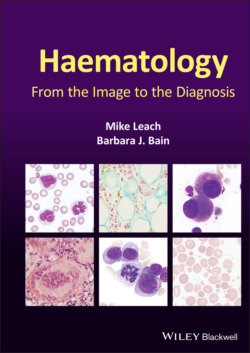Читать книгу Haematology - Barbara J. Bain, Irene Roberts - Страница 30
Оглавление21 Mantle cell lymphoma in leukaemic phase
A 66‐year‐old man presented with dizziness, headaches and difficulty walking. On assessment he was globally confused but had no specific neurological deficit. His full blood count showed Hb 79 g/l, WBC 602 × 109/l and platelets 70 × 109/l. He had splenomegaly but no significant lymphadenopathy. His blood film showed pleomorphic lymphoid cells varying in size from small to large, with condensed nuclear chromatin and prominent nuclear clefts and convolutions, with many of the larger cells showing cytoplasmic vacuoles (all images ×100 objective). Immunophenotyping studies identified a mature CD5−, kappa‐restricted, B‐cell lymphoproliferative disorder expressing CD19, CD20, CD79b, FMC7 and CD38. Immunohistochemistry on the marrow trephine biopsy sections showed the cells to express nuclear cyclin D1 and on karyotypic analysis a t(11;14)(q13;q32) translocation was identified with, in addition, loss of the short arm of chromosome 17 in 60% of cells. The features here are most consistent with leukaemic non‐nodal mantle cell lymphoma.
In view of the presentation, in keeping with cerebral leucostasis, he was treated by leucapheresis and emergency chemotherapy incorporating high‐dose corticosteroids, cyclophosphamide and vincristine. This was followed by six courses of high‐dose cytarabine and rituximab with an incomplete clinical response with persisting splenomegaly on CT imaging. The splenic anatomy remained abnormal with focal hypodense lesions and a splenectomy was performed. This showed extramedullary haemopoiesis but no evidence of residual lymphoma. This patient remains well and in remission 12 years later.
Mantle cell lymphoma constitutes between 3 and 10% of non‐Hodgkin lymphomas. Typically, it involves lymph nodes, but the spleen and bone marrow are also often infiltrated. The disease also has an affinity for the gastrointestinal tract but this may not necessarily be symptomatic. A subset of patients, as in the case presented here, show a leukaemic presentation with splenomegaly but without lymphadenopathy. Leukaemic non‐nodal mantle cell lymphoma is biologically different and paradoxically, despite the leukaemic manifestation, usually has a more indolent course and an appreciably better prognosis (Nadeu et al. 2020). More aggressive forms of the disease can show mutations in TP53, MYC and CDKN2A. The latter is an important tumour suppressor gene encoding proteins which in turn inhibit MDM2 (a physiological inhibitor of the TP53 pathway). Loss or mutation of either CDKN2A or TP53 leads to chemotherapy resistance and MYC mutation is typically associated with proliferative disease. Note the CD5 negativity here; approximately 5% of mantle cell lymphomas are CD5 negative so morphological assessment alongside genetic and immunohistochemical studies are still required in achieving the correct diagnosis.
Reference
1 Nadeu F, Martin‐Garcia D, Clot G, Díaz‐Navarro A, Duran‐Ferrer M, Navarro A et al. (2020) Genomic and epigenomic insights into the origin, pathogenesis, and clinical behavior of mantle cell lymphoma subtypes. Blood, 136, 1419–1432.
MCQ
1 Mantle cell lymphoma:Can result from translocations involving CCND1, CCND2 or CCND3Is derived from marginal zone lymphocytesIs the most common pathology underlying multiple lymphomatous polyposisMay show SOX11 expression on immunohistochemistryUsually expresses CD200For answers and discussion, see page 206.
